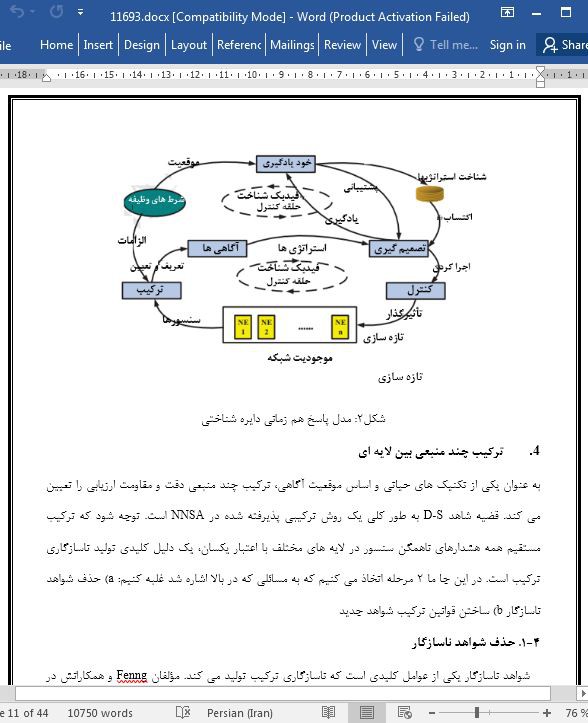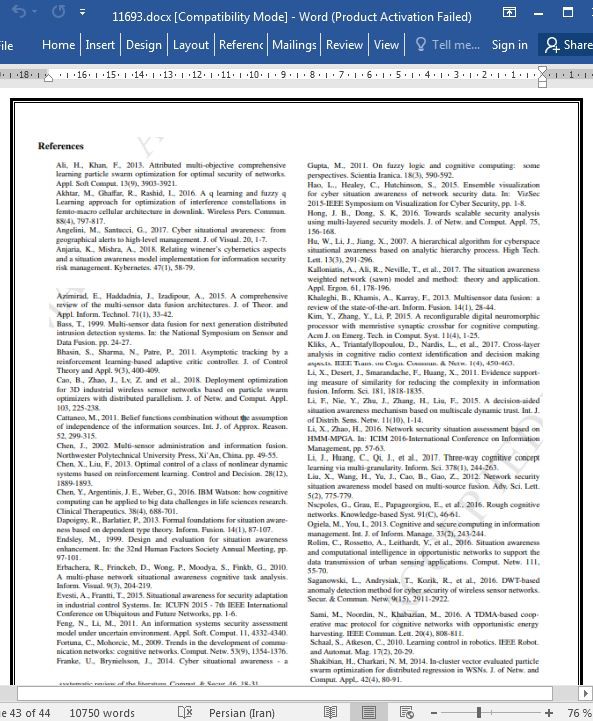
موقعیت آگاهی شبکه: از آگاهی تا کنترل-آگاهی
چکیده
آگاهی موقعیت امنیت شبکه یک قضیه امنیتی است که می تواند تهدید شبکه را از یک دیدگاه کلی بفهمد. در این مقاله ما یک مدل کنترل- آگاهی شناختی (CACM) را برای آگاهی موقعیت امنیت شبکه ارائه می دهیم. مدل کنترل- آگاهی شناختی ساختار بین لایه ای و دایره شناختی را اتخاذ می کند که می تواند در مقابل مانع متقابل بین لایه های مختلف شبکه پیروز شود. در ابتدا ما یک روش تصمیم گیری ترکیبی را پیشنهاد می دهیم که در آن وزن های مختلف به منابع داده مختلف اختصاص می یابد در نتیجه دقت ترکیب می تواند بهبود یابد. دوماً یک رویکرد تعریفی سلسله مراتبی بحث می شود که می تواند از استنتاج اعضای پیچیده بین اجزای شبکه ممانعت کند. در نهایت یک مکانیزم تنظیم شناختی آنالیز می شود که در نتیجه موضوع کنترل اتوماتیک را حل کند. آزمایش های شبیه سازی نشان می دهد که مدل ما می تواند به طور بهینه ای موقعیت خطر را بفهمد و تنظیم کند. در بهترین حالت دانش ما، این اولین بحثی است که از کنترل-آگاهی شناختی بهره می برد تا مسئله تنظیم آگاهی موقعیت امنیت شبکه را حل کند.
1. مقدمه
تکنولوژی شبکه یک بخش صرف نظر نکردنی از سیاست و اقتصاد محلی و جهانی است. این به مرحله بالاتری از قبل در ارائه امنیت ملی و مصلحت رسیده است. ولی در نتیجه ناهمگنی، پیچیدگی و توسعه پیوسته مقیاس سیستمی شبکه اخیر، تکنیک های امنیت شبکه قدیمی از سازگاری و هماهنگی بهینه کمی جهت معامله با مشکلات شبکه برخوردارند. این موضوع باعث خسارات اقتصادی سنگین، تأثیر بد اجتماعی و تصادفات امنیتی مهلک می شود. آگاهی موقعیت امنیت شبکه، نیازهای سیستم شبکه را برآورده می کند و به عنوان یکی از راه حل هایی درنظر گرفته می شود که با چالش های امنیتی رو به رو می شود. این می تواند هشدارهایی که از چندین منابع داده امنیتی گرفته می شود را ترکیب کند و خطر امنیتی را با یک رفتار سریع بفهمد.
8. نتیجه گیری و کارهای آینده
NSSA به یک تکنولوژی جدید در دفاع از شبکه از زمانی که تحت کنترل قرار می گیرد، تبدیل شده است. در طول آنالیز مدل، الگوریتم ترکیب، روش آگاهی و محاسبه شناخت، ما به این نتیجه می رسیم که تحقیق روی NSSA از حالت آگاهی به کنترل-آگاهی پیشرفت کرده است. در ساختار CACM، ما الگوریتم ترکیب چند منبعی غیر متناجس، روش آگاهی سلسله مراتبی و مکانیزم HS-QRL را پیشنهاد می دهیم که به مسائل کنترل-آگاهی شناختی غلبه کنیم. ما روش خود را آزمایش کردیم و تأثیر پذیری و شدنی بودن روش های پیشنهادی را در طول یک سری از آزمایشات شبیه سازی تأیید کردیم. نتیج نشان می دهند که مدل و روش ها می توانند تمایل سیر تکامل موقعیت امنیت را بفهمند و توانایی شناختی مساعدی با ساختن حلقه بسته فیدبک داشته باشند. این مطالعه به هدف کنترل-آگاهی مستقل که می تواند برای ارتقای سطح امنیت استفاده شود، رسیده است و یک رویکرد جدیدی را فراهم می کند که در شبکه مانیتور شده در مقابل هدف حملات مقاوم است.
Abstract
Network Security Situation Awareness (NSSA) is a security theory which can perceive the network threat from a global perspective. In this paper, we present a Cognitive Awareness-Control Model (CACM) for NSSA. CACM adopts the cross-layer architecture and cognitive circle which can break through the interactive barrier between different network layers. Firstly, we propose a decision-level fusion method in which different weights are assigned for different data sources so that the fusion accuracy can be improved. Secondly, a hierarchical quantification approach is discussed which can avoid inferring the complex memberships among network components. Finally, a cognitive regulation mechanism is analysed in order to solve the issue of automatic control. The simulation experiments show that our model can perceive and regulate the threat situation effectively. To the best of our knowledge, this is the first discussion which utilizes cognitive awareness-control to solve the regulation problem of NSSA.
1. Introduction
Network technology becomes an indispensable part of politics and economy either globally or locally. It has reached a higher level than ever before in serving national security and interests. However, due to the heterogeneity, the complexity and the continuous expansion of the scale in current network system, traditional network security techniques are short of adaptability and effective coordination to deal with the network security problems. This results in heavy economic losses, bad social effect and fatal security accidents. Network Security Situation Awareness (NSSA) meets the demands of network system and is regarded as one of the solutions to face the security challenges. It can fuse the alerts acquired from multiple security data sources and perceive the security threat in a real-time manner.
8. Conclusion and future work
NSSA has become a novel technology in defending the networks from being compromised. Through analyzing the model, the fusion algorithm, the awareness method and the cognitive computing, we come to the conclusion that the research on NSSA is pushing ahead form awareness to awareness-control. In the framework of CACM, we proposed our heterogeneous multi-source fusion algorithm, hierarchical awareness method and HS-QRL mechanism to deal with the problem of cognitive awareness-control. We examined our model and validated the effectiveness and feasibility of the proposed methods througha series of simulation experiments. The results show that the model and the methods can perceive the evolution trends of the security situation and possess the favorable cognitive ability by constructing a closed feedback circle. This study has achieved the purpose of autonomous awareness-control which can be used for promoting the security level and providing a new approach to resisting against the attacks aiming at the monitored network.
چکیده
1. مقدمه
2.کارهای مرتبط
3. مدل کنترل-آگاهی شناختی برای NNSA
4. ترکیب چند منبعی بین لایه ای
1-4. حذف شواهد ناسازگار
2-4. ترکیب چند منبعی بهینه سازی ازدحام ذرات DS
5. تعریف آگاهی موقعیت امنیت شبکه
5.1. تعریف عامل موقعیت
5.2. ارزیابی تعیین خطر
6. کنترل شناختی بسته به موقعیت یادگیری تقویتی
6.1. حالت رسمی یادگیری تقویتی در NSSA
6.2. مکانیزم کنترل شناختی
7. آزمایش ها و آنالیز شبیه سازی
7.2. کارایی ترکیب
7.3. تعیین آگاهی سلسله مراتبی
4.7. کنترل شناختی
8. نتیجه گیری و کارهای آینده
Abstract
1. Introduction
2. Related work
3. Cognitive awareness-control model for NSSA
4. Cross-layer multi-source fusion
4.1. Eliminating inconsistent evidence
4.2. PSO-DS multi-source fusion
5. Network security situation quantification awareness
5.1. Situation factor quantification
5.2. Threat quantification evaluation
6. Cognitive control based on reinforce learning
6.1. Formal mode of RL in NSSA
6.2. Cognitive control mechanism
7. Simulation experiments and analysis
7.1. Simulation experiment setup
7.2. Fusion performance
7.3. Hierarchical quantification awareness
7.4. Cognitive control
8. Conclusion and future work
References
Author Biography
- ترجمه فارسی مقاله با فرمت ورد (word) با قابلیت ویرایش، بدون آرم سایت ای ترجمه
- ترجمه فارسی مقاله با فرمت pdf، بدون آرم سایت ای ترجمه



